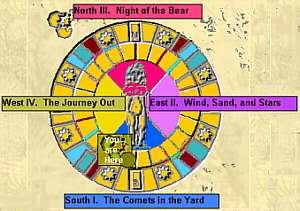|
|

"Ever
since Mnemosyne, the mother of the muses, gave the wax tablet to
mortals, memory, writing and technology have been interconnected.
"
Carolyn recommends these online literary links.

|
Three-Dimensional
Dementia: M.D. Coverley's Califia and the Aesthetics of Forgetting Califia is a genealogical "treasure map" that reconnects a forgotten web of stories and legends of three prospecting California families over five generations. A complex user interface divides the text into four journeyings, each of which is a doorway into the narrative: they are South (The Comets in the Yard), East (Wind, Sand and Stars), North (The Night of the Bear) and West (The Journey Out). The present tense chronicles of Augusta Summerland, Kaye Beveridge and Calvin Lugo show their "speculative reconstructions" (To the Reader--South) of their families' search for the hidden stash of Califia gold. On her home page in the text, Kaye explains: "This effort to put all of the information together will reveal that no part of the story is an isolated incident, all is a part of the whole... we will unearth forgotten relationships, restore the connections, find the harmony beneath the fragments of song." Even though Califia can be read in a linear progression through the four sections, the storylines within each section are anything but linear. Navigated by StarMaps, this is a nomadic quest to trace the fluid connections between fortune, bloodlines, women and the past and the future. "Nomadic consciousness," argues Rosi Braidotti,
Califia is just such a feminist anti-history of navigation where the nomadic reader steers by dead reckoning. Following the seven stars of the big dipper, the reader exits via the solar table into sacred spaces and new lands. An assemblage of narrative, images, documents and prophesies, the text is open-ended and invites the reader to lose herself in a rambling web of the sometimes contradictory pieces comprising the journeys. Augusta's narrative relates the present day chronology of the grail-like quest to solve the riddles that lead to the legendary treasure, but it also tells the story of her mother's decline into the "convoluted labyrinth" of Alzheimer's Disease. 1
| 2 | 3 | 4
| 5 | 6 | 7
| 8 | Sources
|
||

